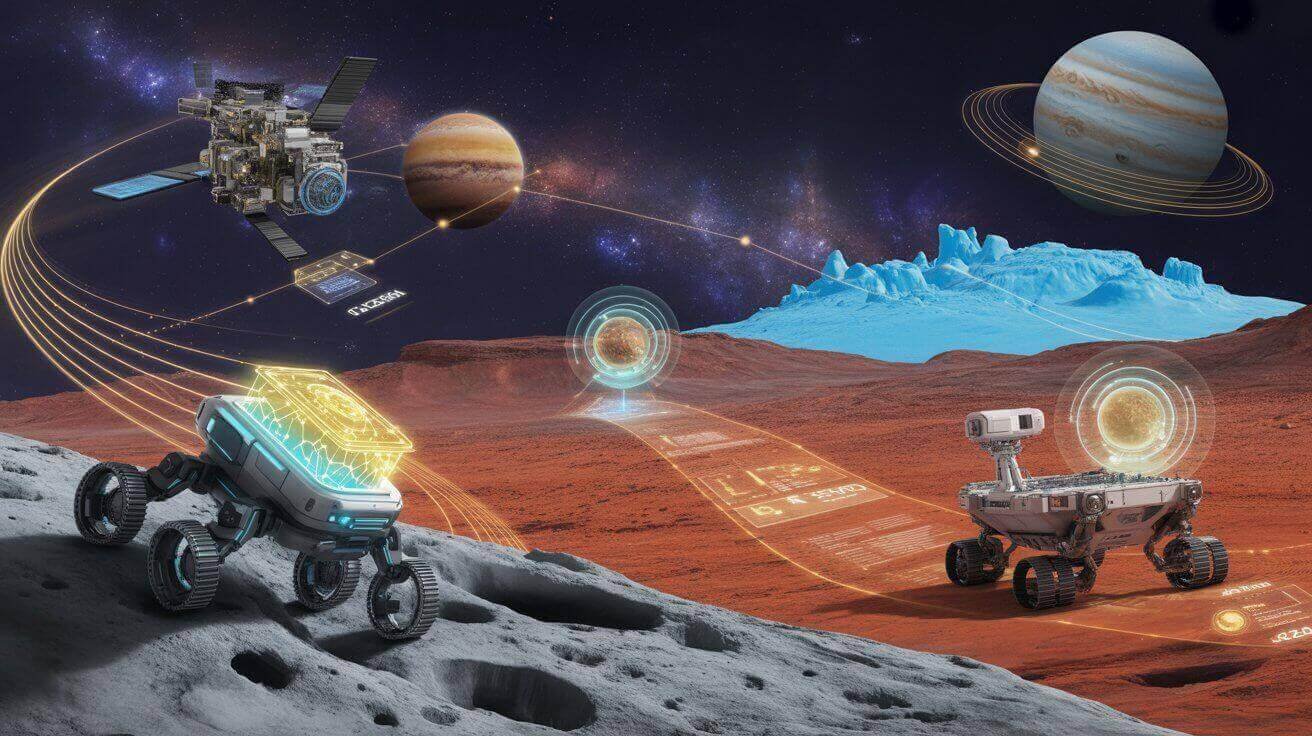Space exploration has reached a turning point. We’re witnessing the dawn of an era where artificial intelligence doesn’t just assist space missions—it leads them. Autonomous space exploration is transforming how we discover new worlds, from Mars rovers making independent decisions to AI systems identifying exoplanets millions of light-years away. Furthermore, autonomous space exploration represents the next evolutionary step in humanity’s quest to understand the cosmos, enabling missions that would be impossible with traditional human-controlled approaches.
The numbers tell a compelling story. Additionally, 88% of the driving done by NASA’s Perseverance rover has been autonomous, while AI systems have already discovered over 50 new exoplanets by analyzing telescope data. Meanwhile, private companies and space agencies are investing billions in developing smarter, more independent spacecraft that can operate without constant human oversight.
The Revolution of Autonomous Space Exploration Technology
AI-Powered Mars Missions Leading the Way
Mars has become our testing ground for autonomous space exploration technology. Currently, NASA’s Perseverance rover demonstrates what’s possible when we combine artificial intelligence with space robotics. Unlike earlier rovers that required constant human input, Perseverance relies heavily on AI to navigate the Martian surface independently and in real-time.
The rover’s PIXL instrument uses AI to search for signs of ancient life by targeting and analyzing rock samples based on curated data from previous missions. Moreover, its AutoNav system allows it to explore Mars without waiting for Earth-based commands, dramatically increasing the amount of scientific work it can accomplish.
Smart Satellites and Deep Space Navigation
Autonomous space exploration extends far beyond planetary rovers. Subsequently, spacecraft are becoming increasingly self-reliant, capable of making critical decisions during the months or years it takes for signals to travel between Earth and distant destinations. For instance, ESA’s Mars Express uses AI to avoid data loss and preserve memory, reducing mission workload by nearly 50%.
Meanwhile, AI-powered navigation systems help spacecraft avoid space debris with 95% accuracy, analyzing tracking data and predicting collision risks in real-time. Therefore, missions can continue operating safely even when human controllers can’t respond quickly enough to emerging threats.
AI Revolutionizing Space Science and Discovery
Exoplanet Detection Through Machine Learning
One of the most exciting applications of autonomous space exploration technology involves discovering planets beyond our solar system. Furthermore, NASA’s ExoMiner deep learning system recently identified 301 new exoplanets by analyzing data from the Kepler Space Telescope that human scientists had previously missed.
AI algorithms can scan thousands of stars and detect tiny dips in brightness that indicate planetary transits. Additionally, these systems filter massive datasets with incredible precision, identifying potential exoplanets while eliminating false positives that would otherwise waste precious observation time.
Processing Astronomical Big Data at Scale
Space telescopes like James Webb and Hubble generate terabytes of information daily—far too much for human teams to process manually. Consequently, AI now filters and analyzes 90% of raw astronomical data before scientists even examine it, dramatically increasing research efficiency.
Autonomous space exploration systems can identify stars, galaxies, and cosmic events while filtering out noise and false signals. For example, AI helps detect gravitational waves from black hole mergers and neutron star collisions by analyzing data from observatories like LIGO and Virgo.
Robotic Pioneers: The Next Generation of Space Explorers
Advanced Robotics for Extreme Environments
The future of autonomous space exploration increasingly depends on sophisticated robotic systems designed for environments humans can’t easily access. Moreover, companies are developing remarkable technologies like the Space Capable Asteroid Robotic Explorer (SCAR-E), a six-legged robot designed to explore asteroids and lunar craters where wheeled vehicles can’t operate.
These robots represent a new class of explorers built specifically for autonomous space exploration missions. Additionally, their AI-driven systems allow them to adapt to unexpected terrain, make independent decisions about where to explore, and conduct scientific experiments without waiting for human instructions.
Asteroid Mining and Resource Extraction
Perhaps nowhere is autonomous space exploration more critical than in the emerging field of space mining. Currently, the global space mining and robots market is expected to reach $4.34 billion by 2030, growing at 11.89% annually as technology makes these missions feasible.
Companies like Karman+ are developing autonomous spacecraft capable of traveling to asteroids, extracting water, and returning to Earth orbit to refuel other spacecraft. Furthermore, these missions require complete autonomy since communication delays make real-time human control impossible.
Practical Applications Transforming Space Operations
Real-World Examples of AI Success in Space
Autonomous space exploration isn’t just theoretical—it’s delivering results today. For instance, the Canadarm2 robotic arm on the International Space Station now performs over 80% of its tasks autonomously, handling everything from capturing cargo spacecraft to assisting with scientific experiments.
Meanwhile, AI systems help mission planners optimize spacecraft trajectories, reducing fuel consumption and mission costs. Subsequently, these systems calculate the most efficient paths while avoiding obstacles like asteroids and space debris, something that would take human teams weeks to accomplish.
Enhanced Safety and Mission Reliability
Safety represents one of the most compelling arguments for autonomous space exploration technology. Additionally, AI systems can predict equipment failures before they occur, analyze system performance in real-time, and execute emergency protocols faster than human operators could respond.
For example, when solar flares threaten spacecraft electronics, AI systems can automatically orient satellites to minimize damage and switch to protected operational modes. Therefore, missions continue operating safely even during hazardous space weather events.
Collaborative Human-AI Exploration
The future doesn’t involve replacing human explorers entirely, but rather creating powerful partnerships between humans and AI. Consequently, autonomous space exploration systems handle routine operations, navigation, and data analysis, freeing human astronauts and scientists to focus on complex problem-solving and discovery.
Current research explores how AI assistants can help astronauts manage daily tasks, monitor health, and provide real-time mission information. Furthermore, these collaborative approaches maximize the strengths of both human creativity and machine precision.
Future Implications: What’s Next for Autonomous Space Exploration
Upcoming Missions Pushing Boundaries
The next decade will see autonomous space exploration technology tested in increasingly ambitious missions. For instance, ESA and JAXA’s Martian Moons eXploration (MMX) mission will use onboard intelligence to land on Phobos, collect samples, and return them to Earth with minimal human intervention.
Meanwhile, NASA’s Europa Clipper mission will rely on AI to navigate around Jupiter’s radiation and make autonomous decisions about which areas of Europa’s ice-covered surface deserve closer study. Subsequently, these missions will demonstrate whether AI can handle the complex, unpredictable challenges of deep space exploration.
The Economics of Intelligent Space Systems
Autonomous space exploration offers compelling economic advantages beyond just scientific discovery. Furthermore, companies are developing missions that can operate for years with minimal ground support, dramatically reducing operational costs compared to traditional human-controlled spacecraft.
Private companies like those selected by the World Economic Forum’s 2025 Technology Pioneers program are using AI to provide customizable space launch services, construct data centers in space, and develop breakthrough technologies that address global challenges.
Challenges and Ethical Considerations
Despite its promise, autonomous space exploration faces significant challenges that need addressing. Moreover, questions arise about decision-making authority when AI systems encounter unexpected situations millions of miles from Earth. Additionally, cybersecurity becomes critical when spacecraft operate independently for extended periods.
There’s also the question of international cooperation and space governance. Therefore, as AI-powered spacecraft become more capable, we need frameworks for ensuring peaceful exploration and preventing conflicts over space resources.
Conclusion: Embracing the Age of Intelligent Space Exploration
We’re entering an era where autonomous space exploration will fundamentally change how humanity explores the cosmos. From AI-powered rovers discovering ancient life on Mars to robotic miners extracting resources from asteroids, intelligent systems are expanding the boundaries of what’s possible in space.
The technology is advancing rapidly, with AI systems already demonstrating remarkable capabilities in current missions. Furthermore, the investment flowing into autonomous space exploration from both government agencies and private companies suggests this trend will only accelerate.
As we look toward the future, the combination of artificial intelligence and space exploration offers unprecedented opportunities for scientific discovery, economic development, and expanding human presence beyond Earth. However, success will require thoughtful planning, international cooperation, and careful attention to safety and ethics.
Autonomous space exploration represents more than just technological advancement—it’s our pathway to becoming a truly spacefaring civilization. Therefore, the decisions we make today about developing and deploying these systems will shape humanity’s relationship with space for generations to come.
The age of intelligent space exploration has begun, and the possibilities are as limitless as the cosmos itself.








